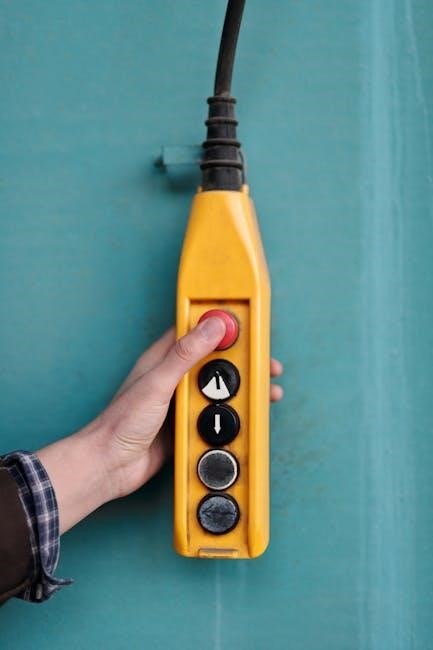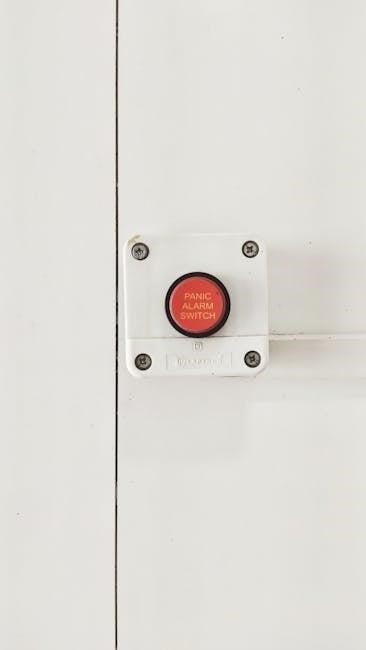This manual serves as your go-to guide for understanding and optimizing the JS Bull eBike Controller, ensuring a seamless and safe riding experience.
It covers essential features, setup, and troubleshooting, helping you maximize performance and maintain your eBike controller effectively, whether you’re a novice or an experienced rider.
1.1 Overview of the JS Bull eBike Controller
The JS Bull eBike Controller is a sophisticated electronic system designed to regulate and enhance your eBike’s performance. It acts as the central nervous system, managing power delivery, speed, and battery efficiency. With advanced settings and real-time monitoring, it ensures a smooth and customizable riding experience. The controller is compatible with various eBike models and offers features like customizable power modes, safety protocols, and diagnostic tools. Its user-friendly interface makes it accessible for both novice and experienced riders, providing unparalleled control over your eBike’s operation.
1.2 Importance of the Manual for eBike Owners
The JS Bull eBike Controller Manual is an essential resource for eBike owners, providing detailed insights into the controller’s functionality and operation. It equips riders with the knowledge to customize settings, troubleshoot issues, and optimize performance. Whether you’re a novice or an experienced rider, this guide ensures safe and efficient use of your eBike. By understanding the controller’s capabilities and limitations, you can enhance your riding experience and maintain your eBike’s longevity. This manual is your key to unlocking the full potential of your JS Bull eBike Controller.

Understanding the JS Bull eBike Controller
The JS Bull eBike Controller is a critical component that manages your eBike’s power and performance. Understanding its functions and capabilities ensures optimal use and customization.
2.1 Key Components of the Controller
The JS Bull eBike Controller comprises essential components like the MCU (Microcontroller Unit), MOSFETs for power management, sensors for monitoring speed and torque, and a communication module for connecting accessories. These parts work together to regulate power delivery, ensure safety, and provide real-time feedback. The MCU acts as the brain, processing inputs from sensors and adjusting motor output. MOSFETs handle high-current switching, while the communication module enables compatibility with displays, throttles, and other components. Understanding these components is vital for troubleshooting and customization.
2.2 How the Controller Interacts with Other eBike Parts
The JS Bull eBike Controller acts as the central hub, connecting and coordinating with key components like the motor, battery, throttle, and brakes. It communicates with the display unit to show real-time data and receives input from the throttle and brake sensors. The controller regulates power flow from the battery to the motor, ensuring efficient and safe operation. It also integrates with pedal-assist sensors to optimize assistance levels based on rider input, creating a seamless and responsive riding experience.

Installation Guide
Begin by verifying compatibility with your eBike model and ensuring all components are included. Disconnect the battery for safety before starting the installation process.
3.1 Pre-Installation Checks
Before installing the JS Bull eBike Controller, ensure compatibility with your eBike model by checking the specifications. Verify that all necessary components are included in the package.
Inspect the controller and wiring for any visible damage. Charge the battery to ensure it has enough power for the installation process. Disconnect the battery to prevent any electrical hazards during setup.
3.2 Step-by-Step Installation Process
Begin by disconnecting the battery to ensure safety. Locate the controller mounting position and secure it firmly using the provided hardware. Connect the battery to the controller, followed by the motor and brakes.
Next, link the throttle and pedal assist sensor, ensuring proper alignment. Reconnect the battery and power on the system to test functionality. Double-check all connections for security and integrity.
3.3 Post-Installation Testing
After installation, perform a thorough test to ensure all components function correctly. Start by checking the brakes, throttle, and pedal assist in a safe, stationary environment.
Verify that the motor responds smoothly to input and that the controller displays accurate readings. Check for any error codes or unusual behavior.
Finally, conduct a short test ride to confirm proper operation of all systems, ensuring a safe and optimal riding experience.

Configuration and Settings
Learn how to customize your eBike’s performance by adjusting parameters like speed limits, pedal assist levels, and torque settings to suit your riding style and preferences.
4.1 Accessing the Controller Settings
To access the JS Bull eBike Controller settings, use the provided display or connect via a mobile app, ensuring you have the correct credentials or physical access.
Refer to the manual or online guides for step-by-step instructions, as improper configuration can affect performance or safety.
Connect the controller to a power source, navigate through the menu using the control panel, and adjust settings carefully to avoid malfunctions.
Always save changes before exiting to ensure your custom preferences are applied.
4.2 Customizing Settings for Optimal Performance
Customizing the JS Bull eBike Controller settings allows you to tailor your riding experience to your preferences and terrain conditions.
Adjust parameters such as assist levels, speed limits, and torque settings to optimize power delivery and battery efficiency.
Modify acceleration sensitivity and regenerative braking to suit your riding style, ensuring smooth and responsive handling.
Experiment with custom profiles for different scenarios, like city commuting or off-road adventures, to maximize performance and safety.
Always test settings incrementally and consult the manual for guidance to avoid unintended behavior.
4.3 Updating Firmware
Regularly updating the JS Bull eBike Controller firmware is crucial for unlocking new features, improving performance, and fixing bugs.
Download the latest firmware from the manufacturer’s website and follow the step-by-step instructions provided in the manual or online support resources.
Ensure the eBike is fully charged and connected to a computer or smartphone via the recommended interface to avoid interruptions during the update process.
After updating, test the controller to confirm all functions operate correctly and settings remain optimized for your riding preferences.
Never disconnect power during an update to prevent potential system corruption.

Troubleshooting Common Issues
Identify and resolve issues with the JS Bull eBike Controller by checking error codes, verifying connections, and ensuring proper firmware installation.
Refer to the manual for diagnostic tools and step-by-step solutions to address common faults and restore optimal functionality.
5.1 Diagnosing Controller-Related Problems
Diagnosing issues with the JS Bull eBike Controller begins with identifying symptoms such as error codes, unexpected shutdowns, or loss of power.
- Check for loose connections or damaged wires that may disrupt communication between components.
- Review recent software updates or settings changes that could trigger malfunctions.
- Use the controller’s diagnostic tools to scan for internal faults or corrupted firmware.
Consult the manual for specific error code meanings and follow the recommended troubleshooting steps to isolate and resolve the issue effectively.
5.2 Solutions for Common Faults
Common faults with the JS Bull eBike Controller often relate to connectivity, power issues, or software glitches. For error codes, refer to the manual for specific solutions.
- Restart the controller to reset its system and clear temporary glitches.
- Check and tighten all electrical connections to ensure proper communication.
- Update the firmware to the latest version if an outdated version is causing issues.
- Perform a factory reset as a last resort, ensuring all settings are backed up first.
Regular maintenance and software updates can prevent many of these issues from occurring.
5.3 Resetting the Controller
Resetting the JS Bull eBike Controller can resolve software-related issues without affecting custom settings. To perform a soft reset, power off the eBike, then press and hold the power button for 10 seconds. For a factory reset, navigate to the settings menu, select “Advanced,” and choose “Restore Default Settings.” This will revert all configurations to original factory settings, so ensure you backup your customizations first. Regular resets can help maintain optimal performance and address unforeseen software glitches effectively.

Safety Precautions
Always wear protective gear and follow safety guidelines when handling the JS Bull eBike Controller. Ensure proper electrical connections and avoid overcharging batteries to prevent hazards.
6.1 General Safety Guidelines
Always wear protective gear, including gloves and safety glasses, when working with the JS Bull eBike Controller. Ensure the eBike is on a stable surface and turned off before performing any maintenance. Avoid overcharging the battery and keep it away from flammable materials. Never ride in hazardous conditions or exceed the recommended weight limit. Regularly inspect the controller and electrical connections for damage or wear. Follow all local safety regulations and manufacturer recommendations to ensure a safe and enjoyable riding experience.
6.2 Handling Electrical Components Safely
When handling the JS Bull eBike Controller’s electrical components, always disconnect the battery first to prevent accidental power surges. Use insulated tools to avoid electric shock. Ensure the eBike is turned off and grounded before any maintenance. Never expose electrical parts to water or moisture, as this can cause irreversible damage. Always refer to the manual for specific guidelines on handling sensitive electronics. If unsure, consult a professional to avoid risks. Proper handling ensures both your safety and the longevity of the controller.
6.3 Emergency Procedures
In case of an emergency, immediately turn off the JS Bull eBike Controller and disconnect the battery to prevent further issues. If you experience a system failure, stop the eBike safely and avoid sudden movements. For electrical malfunctions, such as short circuits, unplug the battery and contact a professional. Never attempt repairs while the system is powered on. Keep a fire extinguisher nearby when working with electrical components. Always follow the manual’s guidelines for emergency situations to ensure your safety and prevent damage to the controller.

Maintenance and Upkeep
Regular maintenance ensures the JS Bull eBike Controller operates smoothly and lasts longer. Schedule inspections, clean components, and update software to maintain optimal performance and safety.
7.1 Regular Maintenance Schedule
A well-planned maintenance schedule is crucial for the longevity of your JS Bull eBike Controller. Inspect electrical connections monthly to ensure they are secure and free from corrosion. Every three months, check the firmware for updates and clean the controller’s exterior gently with a soft cloth. Annually, have a professional inspect the internal components and wiring for wear or damage. Regular servicing ensures optimal performance, prevents unexpected failures, and keeps your eBike running smoothly year-round.
7.2 Cleaning and Inspecting the Controller
Regular cleaning and inspection of the JS Bull eBike Controller are vital for maintaining its efficiency and reliability. Use compressed air to gently remove dust and debris from vents and surfaces. Avoid harsh chemicals or liquids, as they may damage electrical components. Inspect wires and connections for signs of wear, fraying, or corrosion. Check for any physical damage or loose screws. After cleaning, ensure all components are dry before reconnecting the power. This routine helps prevent malfunctions and ensures the controller operates at peak performance.
7.3 Storage Recommendations
Proper storage of the JS Bull eBike Controller is essential to maintain its longevity and functionality. Store it in a cool, dry place, away from direct sunlight and heat sources. Avoid extreme temperatures and humidity. Use a protective cover or case to shield it from dust and physical damage. If storing for an extended period, ensure the battery is charged to at least 50% to prevent deep discharge. Regularly inspect the controller during storage to ensure no damage or degradation occurs. Proper storage practices ensure the controller remains reliable when you’re ready to use it again.

Advanced Features
The JS Bull eBike Controller offers advanced features like customizable ride modes, regenerative braking, and smart power management for enhanced performance and efficiency. Explore these settings to personalize your eBike experience and optimize its capabilities for various terrains and riding styles, ensuring a smoother and more enjoyable journey.
8.1 Exploring Customization Options
The JS Bull eBike Controller allows riders to tailor their experience through customizable settings, such as ride modes, torque sensitivity, and regenerative braking levels. These adjustments enable personalized performance, ensuring optimal power delivery for different terrains and riding styles. By tweaking these settings, users can enhance efficiency, comfort, and overall control, making every ride more enjoyable and tailored to their preferences. This level of customization empowers riders to unlock the full potential of their eBike, whether commuting or exploring off-road trails.
8.2 Using the Controller’s Diagnostic Tools
The JS Bull eBike Controller features advanced diagnostic tools designed to monitor and analyze system performance. These tools help identify potential issues, such as faulty sensors or connectivity problems, ensuring timely resolutions. Riders can access detailed error codes and real-time data through the controller’s interface or compatible apps. Regular use of these diagnostic features promotes proactive maintenance, preventing unexpected breakdowns and optimizing overall eBike performance. This functionality is especially valuable for troubleshooting and ensuring the controller operates at peak efficiency.
8.3 Integrating Third-Party Accessories
The JS Bull eBike Controller supports integration with various third-party accessories, enhancing your riding experience. Compatibility with GPS devices, customizable displays, and additional sensors allows for personalized setup. Ensure all accessories are compatible with the controller’s firmware and electrical specifications. Proper installation and configuration are essential to maintain optimal performance and safety. Always test new accessories before extended use and refer to the manufacturer’s guidelines for seamless integration. This feature empowers riders to tailor their eBike to specific needs and preferences effectively.

Legal and Regulatory Compliance
Ensure your JS Bull eBike operates within local regulations for safety and legality. Proper controller settings maintain compliance, while unauthorized modifications may lead to legal issues.
9.1 Understanding Local eBike Regulations
Understanding local eBike regulations is crucial for legal and safe operation. Laws vary by region, often focusing on power output, speed limits, and permissible bike paths. Ensure your JS Bull eBike meets local standards to avoid fines or restrictions. Familiarize yourself with requirements like helmets, age restrictions, and lighting systems. Some areas may require specific certifications or permits, so always verify before modifying your eBike. Compliance ensures a hassle-free riding experience while maintaining safety for yourself and others on the road.
Research your local transportation authority’s guidelines to confirm the allowable specifications for your eBike. This includes motor power, battery wattage, and maximum assisted speed. Non-compliant modifications could lead to legal consequences. Always follow manufacturer recommendations and local laws when adjusting your JS Bull eBike controller settings. Staying informed helps you avoid penalties and ensures your eBike remains road-legal. Additionally, engage with local cycling communities or forums for updates on regulatory changes affecting your eBike usage.
9.2 Ensuring Compliance with Controller Settings
Ensuring compliance with local regulations involves properly configuring your JS Bull eBike controller. Adjust settings to meet legal limits for power output, speed, and torque. Use the manual to guide you in modifying controller parameters without violating laws. Regularly check and update settings to align with changing regulations or regional requirements. This ensures your eBike remains street-legal and avoids potential penalties or restrictions on usage.
Refer to your local transportation authority’s guidelines for specific limits. Use diagnostic tools to verify settings and maintain compliance. Updating firmware can also help ensure your controller stays within legal boundaries. Always prioritize safety and adherence to regulations when customizing your eBike’s performance. Compliance not only avoids legal issues but also enhances overall riding safety and community acceptance of eBikes.
9.3 Legal Implications of Modifications
Modifying your JS Bull eBike controller can have legal consequences if it alters the bike’s performance beyond local regulations. Changes to power output or speed limits may reclassify your eBike, requiring additional licensing or insurance. Always verify modifications against local laws to avoid fines or confiscation. Ensure any alterations comply with safety and legal standards to maintain roadworthiness and avoid penalties.
Consult local authorities or legal experts before making significant changes. Non-compliant modifications can invalidate warranties or insurance coverage. Stay informed about legal requirements to ensure your eBike remains street-legal and safe to operate.

Community and Support Resources
Engage with online forums, join eBike communities, and explore tutorials for troubleshooting and customization. Manufacturer support and user-generated content offer valuable insights and solutions.
10.1 Online Forums and Communities
Online forums and communities are invaluable resources for eBike enthusiasts. Platforms like Facebook groups and Reddit forums dedicated to eBikes offer a space to share experiences, ask questions, and learn from experts. Many users have found success troubleshooting issues and discovering customization tips through these channels. Additionally, communities often provide reviews and recommendations for accessories and upgrades, helping you enhance your JS Bull eBike Controller setup. Engaging with these groups can foster connections and provide hands-on advice from experienced riders and technicians.
10.2 Contacting Manufacturer Support
Contacting the manufacturer’s support team is essential for resolving technical issues or clarifying doubts about your JS Bull eBike Controller. Most manufacturers provide dedicated support channels, such as email, phone, or live chat, ensuring prompt assistance. Reaching out to support can help you access official documentation, troubleshooting guides, and software updates tailored to your controller. Additionally, support teams can address warranty-related inquiries and provide guidance for repairs or replacements, ensuring your eBike operates smoothly and safely.
10.3 Workshops and Tutorials
Workshops and tutorials are excellent resources for mastering the JS Bull eBike Controller. These sessions, often available online or in-person, provide hands-on training and detailed insights into controller setup, customization, and troubleshooting. Many tutorials include step-by-step guides, practical exercises, and live demonstrations, helping you optimize your eBike’s performance. Whether you’re a beginner or an experienced rider, these educational opportunities bridge the gap between theory and practice, ensuring you get the most out of your JS Bull eBike Controller.